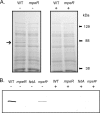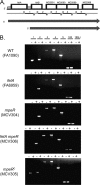The iron-repressed, AraC-like regulator MpeR activates expression of fetA in Neisseria gonorrhoeae
- PMID: 21947770
- PMCID: PMC3232672
- DOI: 10.1128/IAI.05806-11
The iron-repressed, AraC-like regulator MpeR activates expression of fetA in Neisseria gonorrhoeae
Abstract
Neisseria gonorrhoeae is an obligate human pathogen that causes the common sexually transmitted infection gonorrhea. Gonococcal infections cause significant morbidity, particularly among women, as the organism ascends to the upper reproductive tract, resulting in pelvic inflammatory disease, ectopic pregnancy, and infertility. In the last few years, antibiotic resistance rates have risen dramatically, leading to severe restriction of treatment options for gonococcal disease. Gonococcal infections do not elicit protective immunity, nor is there an effective vaccine to prevent the disease. Thus, further understanding of the expression, function, and regulation of surface antigens could lead to better treatment and prevention modalities in the future. In the current study, we determined that an iron-repressed regulator, MpeR, interacted specifically with the DNA sequence upstream of fetA and activated FetA expression. Interestingly, MpeR was previously shown to regulate the expression of gonococcal antimicrobial efflux systems. We confirmed that the outer membrane transporter FetA allows gonococcal strain FA1090 to utilize the xenosiderophore ferric enterobactin as an iron source. However, we further demonstrated that FetA has an extended range of substrates that encompasses other catecholate xenosiderophores, including ferric salmochelin and the dimers and trimers of dihydroxybenzoylserine. We demonstrated that fetA is part of an iron-repressed, MpeR-activated operon which putatively encodes other iron transport proteins. This is the first study to describe a regulatory linkage between antimicrobial efflux and iron transport in N. gonorrhoeae. The regulatory nidus that links these systems, MpeR, is expressed exclusively by pathogenic neisseriae and is therefore expected to be an important virulence factor.
Figures







Similar articles
-
MpeR regulates the mtr efflux locus in Neisseria gonorrhoeae and modulates antimicrobial resistance by an iron-responsive mechanism.Antimicrob Agents Chemother. 2012 Mar;56(3):1491-501. doi: 10.1128/AAC.06112-11. Epub 2012 Jan 3. Antimicrob Agents Chemother. 2012. PMID: 22214775 Free PMC article.
-
The fbpABC operon is required for Ton-independent utilization of xenosiderophores by Neisseria gonorrhoeae strain FA19.Infect Immun. 2011 Jan;79(1):267-78. doi: 10.1128/IAI.00807-10. Epub 2010 Nov 1. Infect Immun. 2011. PMID: 21041493 Free PMC article.
-
Ferric enterobactin binding and utilization by Neisseria gonorrhoeae.J Bacteriol. 1999 May;181(9):2895-901. doi: 10.1128/JB.181.9.2895-2901.1999. J Bacteriol. 1999. PMID: 10217784 Free PMC article.
-
Transcriptional regulation of the mtrCDE efflux pump operon: importance for Neisseria gonorrhoeae antimicrobial resistance.Microbiology (Reading). 2022 Aug;168(8):001231. doi: 10.1099/mic.0.001231. Microbiology (Reading). 2022. PMID: 35916832 Free PMC article. Review.
-
The ironclad truth: how in vivo transcriptomics and in vitro mechanistic studies shape our understanding of Neisseria gonorrhoeae gene regulation during mucosal infection.Pathog Dis. 2017 Jul 31;75(5):ftx057. doi: 10.1093/femspd/ftx057. Pathog Dis. 2017. PMID: 28520925 Free PMC article. Review.
Cited by
-
Association between dietary intakes and pregnancy complications: a two-sample Mendelian randomization analysis.BMC Pregnancy Childbirth. 2025 Mar 14;25(1):286. doi: 10.1186/s12884-025-07385-7. BMC Pregnancy Childbirth. 2025. PMID: 40087593 Free PMC article.
-
Viral vectors expressing group B meningococcal outer membrane proteins induce strong antibody responses but fail to induce functional bactericidal activity.J Infect. 2022 May;84(5):658-667. doi: 10.1016/j.jinf.2022.02.032. Epub 2022 Mar 1. J Infect. 2022. PMID: 35245584 Free PMC article.
-
Iron homeostasis in the Rhodobacter genus.Adv Bot Res. 2013;66:10.1016/B978-0-12-397923-0.00010-2. doi: 10.1016/B978-0-12-397923-0.00010-2. Adv Bot Res. 2013. PMID: 24382933 Free PMC article.
-
MpeR regulates the mtr efflux locus in Neisseria gonorrhoeae and modulates antimicrobial resistance by an iron-responsive mechanism.Antimicrob Agents Chemother. 2012 Mar;56(3):1491-501. doi: 10.1128/AAC.06112-11. Epub 2012 Jan 3. Antimicrob Agents Chemother. 2012. PMID: 22214775 Free PMC article.
-
IurV, Encoded by ORF VCA0231, Is Involved in the Regulation of Iron Uptake Genes in Vibrio cholerae.Genes (Basel). 2020 Oct 12;11(10):1184. doi: 10.3390/genes11101184. Genes (Basel). 2020. PMID: 33053678 Free PMC article.
References
-
- Ala'Aldeen D. A., Wall R. A., Borriello S. P. 1990. Immunogenicity and cross-reactivity of the 70-Kda iron-regulated protein of Neisseria meningitidis in man and animals. J. Med. Microbiol. 32: 275–281 - PubMed
-
- Anderson J. E., Hobbs M. M., Biswas G. D., Sparling P. F. 2003. Opposing selective forces for expression of the gonococcal lactoferrin receptor. Mol. Microbiol. 48: 1325–1337 - PubMed
-
- Archibald F. S., Simonson C., DeVoe I. W. 1981. Comparison of iron binding and uptake from FeCl3 and Fe-citrated by Neisseria meningitidis. Can. J. Microbiol. 27: 1066–1070 - PubMed
-
- Bagg A., Neilands J. B. 1987. Ferric uptake regulation protein acts as a repressor, employing iron (II) as a cofactor to bind the operator of an iron transport operon in Escherichia coli. Biochemistry 26: 5471–5477 - PubMed
Publication types
MeSH terms
Substances
Grants and funding
LinkOut - more resources
Full Text Sources
Medical
Molecular Biology Databases

